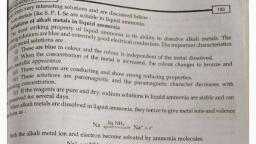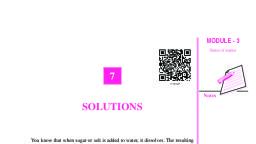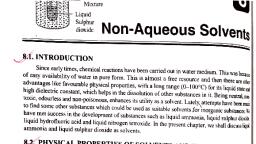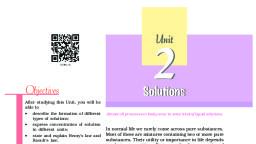Page 1 :
SechoOn 6.1, Voeabulary, , Name Date, , -@ Use with textbook pages 160-164., , ” Golutes and solvents, , Read section 6.1 about solutes and solvents., , , , , , Vocabulary, , , , soluble insoluble concentration dilute solution, , , , concentrated solution, , , , , , Use the terms in the vocabulary box above to fill in the blanks. Use each, term only once. Then write a sentence to show you understand each term., , 12 C—‘“‘ ‘CO; means abie to dissoive in a certain solvent., , , , , , > 2. A material that is unable to dissolve in a certain substance is, , , , , , 3. A(n) has a large mass of dissolved solute for a, certain quantity of solvent., , , , , , 4. The quantity of solute that is dissolved in a certain quantity of solvent is the, of the solution., , , , 5. A(n) _-_________ has a small mass of dissolved solute for a, certain quantity of solvent., , , , © 2004 McGraw-Hill Ryerson Limited Chapter6 Exploring Solutions * MHR_ 117
Page 2 :
Mlustrating, Concepts, , Name Date, , , , Use with textbook pages 160-164., , Ilustrating dilute and, concentrated solutions, , The particle model of matter provides a way to visualize the particles in, solutions. For example, look at Figure 6.3 C on page 162 of your textbook., Create similar models to illustrate the situations described below., , , , Use the particle model to draw how the particles of the liquid look at, the end of each of the following steps., , 1. A student has some pure water., 2. The student adds a little sugar to the water and stirs until all the sugar dissolves., , 3. Then the student adds a lot more sugar to the water and stirs until it all dissolves., , , , , , , , , , , , , , , , , , 1. Pure water 2. Water + a little sugar 3. Water + a lot more sugar Xf, , (dilute solution) (concentrated solution), , ©, , 112 MHR ¢ Unit2 Chemistry © 2004 McGraw-Hill Ryerson Limited
Page 3 :
Section 6.1, Comprehension, , Name Date, , Use with textbook pages 160-164, , ~ 'True or false?, , Read section 6.1 about solutes and solvents., , , , Read the statements given below. If the statement is true, write “T”, on the line in front of the sentence. If it is false, write “F” and circle, the word or words that make it false., , 1. __ Soluble substances can dissolve in certain solvents., /, 2. ___ Insoluble substances can dissolve in all solvents., 3. ___ All substances are soluble in water, which is called the “universal solvent.”, 4, ___ Table salt is insoluble in water., 5. __ Grass stains are difficult to wash out because chlorophyll is insoluble in water., 6. ___ When sugar dissolves in water, water particles pull sugar particles off the, , sugar crystal., , , , 7. ___ Water particles are not actually water molecules., 8. __ Concentrated solutions contain a large amount of solute for a certain volume, of solvent., 9. ___ Dilute solutions contain a large amount of solute for a certain volume of solvent., 10. __ Solutions with high concentrations of solutes are concentrated., 11. Solutions with low concentrations of solutes are dilute., 12. __ You can decrease the concentration of a solution by adding more solute., , © 2004 McGraw-Hill Ryerson Limited Chapter 6 Exploring Solutions * MHR 113
Page 4 :
Applying, Knowledge, , Name Date, , Use with textbook pages 160-164., , Solutes and solvents, , Define the terms “solute” and “solvent” in your own words., Then list the solvent and the solute for each solution that follows., , , , Define these terms in your own words., , 1. Solute:, , , , 2. Solvent: __, , For each solution, identify the solvent and the solute., , 3. Taku mixed some water and juice crystals to make a fruit drink., (a) The soluteis_ ©, , (b) The solventis_, , 4. Kim swished salt water in her mouth after she lost her tooth in a soccer game., (a) The solute is, , (b) The solvent is, , 5. Rosanna put rubbing alcohol on the grass stain that was on her sock., (a) The solute is__, , (b) The solvent is . \, , 6. Justin added a little sugar to his tea because it tasted bitter., (a) The solute is_, , (b) The solvent is, , 7. The tea from Mei’s tea bag coloured the water as it brewed., , (a)Thesoluteis ©, U, (b) The solventis_, , , , , , 114 MHR ° Unit2 Chemistry © 2004 McGraw-Hill Ryerson Limited
















































